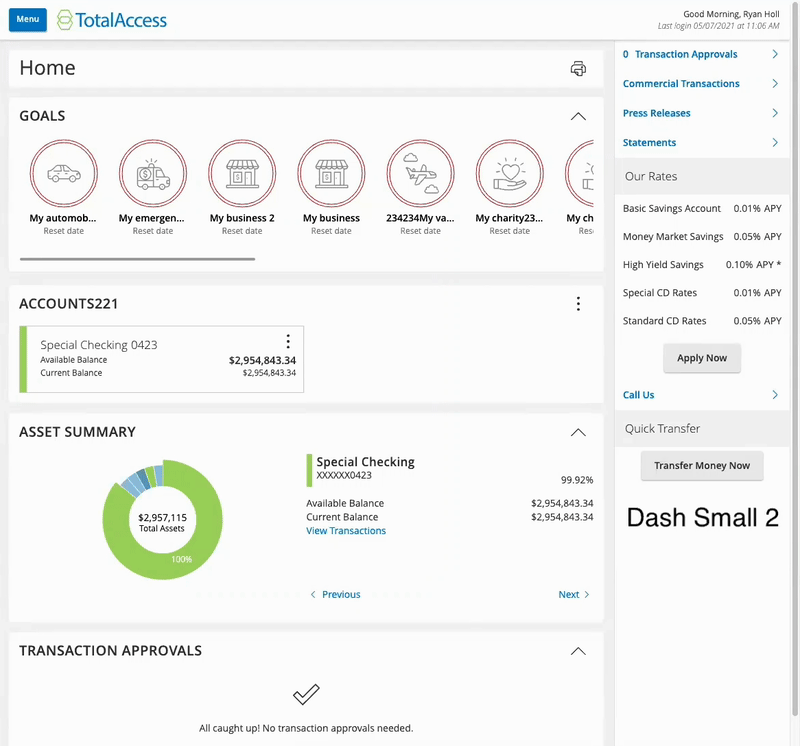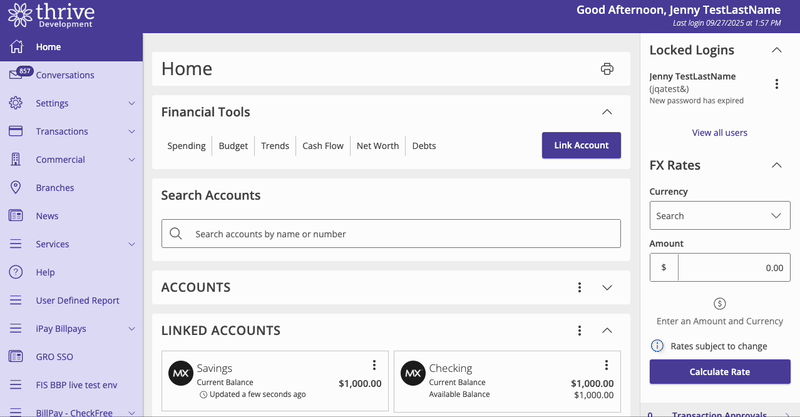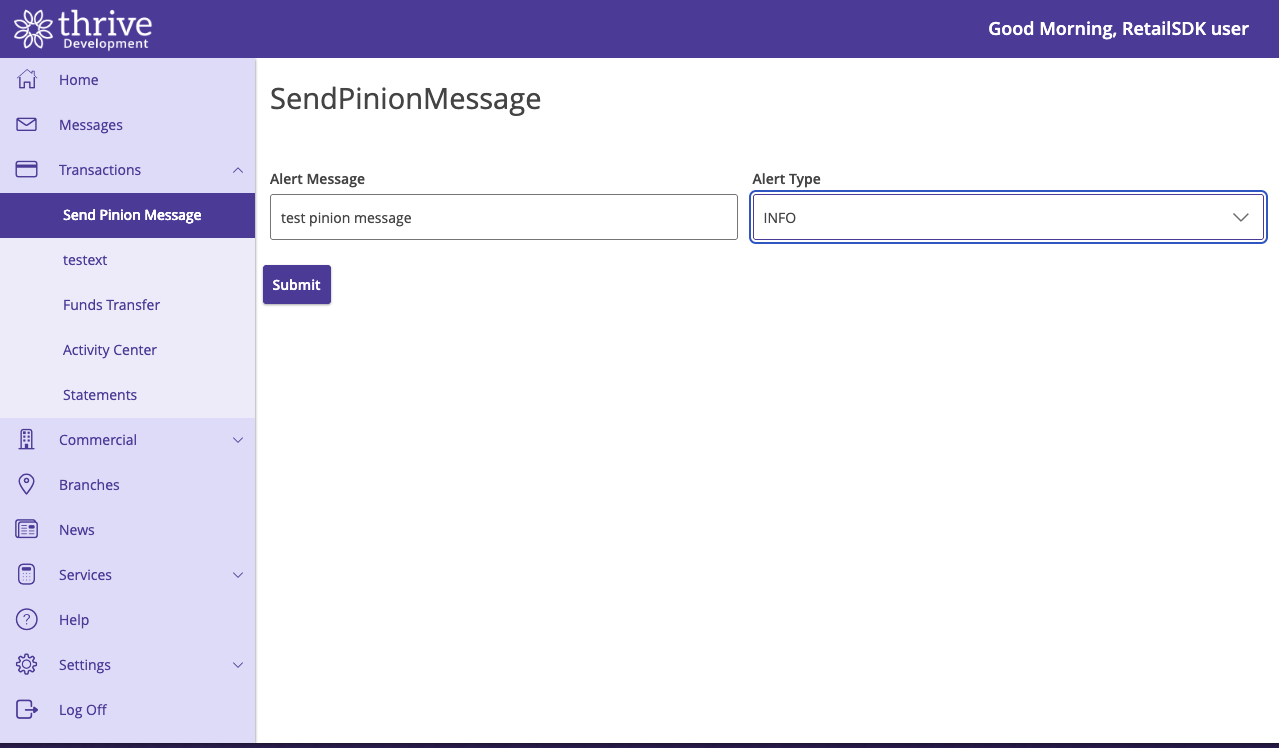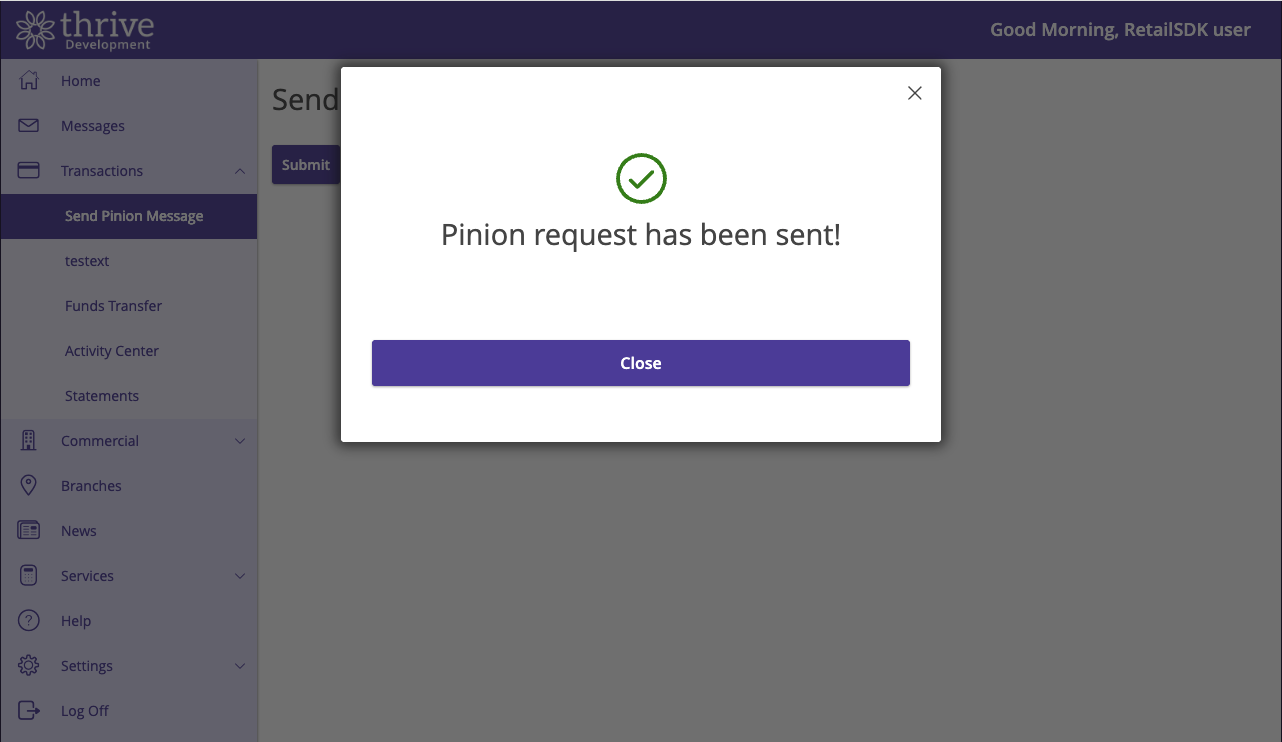Pinion
Important
Environment requirements
Pinion requires stack-level configuration. If you run into any issues, please create a ticket in the Q2 Developer Portal for enablement assistance.
Pinion support depends on your UUX version. Integration requires a stack minimum UUX version of v4.6.1.2.
Overview
What is Pinion?
Pinion is a set of services that deliver real-time, asynchronous notifications directly into a user’s Online Banking session via a socket.io connection.
It was designed to surface external, event-driven changes (e.g., “this account balance just updated,” “show this alert now”) without requiring a user refresh.
With Pinion, you can:
Send notifications to an end user or broadcast to all users at a Financial Institution (FI).
Trigger real-time account refreshes to ensure balances and account lists remain accurate.
Deliver alerts (info, success, warning, error) with message text, closable behavior, and display duration.
Surface third-party events in-session through UUX.
How Messages Are Addressed
Pinion notifications can be routed in multiple ways:
Direct notification to a logged in user (specified using the
MSG_TYPE_GENERALNotificationRoutingType).Broadcast notification to all users in an FI (specified using the
MSG_TYPE_FINotificationRoutingType).
Templates
We have created ready-to-use templates for common scenarios. These are strongly recommended for consistency and reliability.
Account Refresh Template

The Account Refresh template reloads accounts for users currently in session, based on provided transaction IDs. This ensures a user’s account view reflects the latest state without requiring a manual refresh.
See Account Refresh Template for full details.
Alert Template

The Alert template displays a visible pop-up notification in UUX. You can configure:
The alert type:
info,success,warning,errorWhether the user can dismiss the alert (
closableparameter)Duration of the alert before it auto-closes
See Alert Template for details.
Note
If you need more flexibility, a generic BaseTemplate exists for custom payloads.
Walkthrough: Sending a Pinion Notification
In this tutorial, we’ll build a minimal Online extension that allows you to send a Pinion notification. You can adapt this example to your appropriate extension type.
You’ll learn how to:
Create the extension
Add a simple UI
Construct and send an Alert
Adapt the same flow for Account Refresh
Important
Pinion is not supported in SDK sandbox environments as all parts of the Pinion architecture are not deployed to these stacks. You must promote your extension to staging to test end-to-end.
Step 1: Create the extension
To start, run the following command in your terminal:
$ q2 create_extensionWhen prompted, enter a name such as
SendPinionMessage. Names must be unique across your organization if multiple developers are going through this tutorial.
Step 2: Pick the Extension type
For the prompt, select Online (default):
What type of extension are you creating? 1) Online (default) <-------- 2) SSO (Third Party Integration) 3) Ardent (API) 4) Q2Console (Backoffice) 5) Central (Legacy Backoffice) 6) Adapter 7) Audit Action 8) Custom Health Check 9) Message Bus 10) Caliper API Custom Endpoint 11) Base Extension Please make a selection and press Return [1]: 1Choose
Server Side Rendered (Default)andAuthenticated (Default)on subsequent prompts.
Step 3: Build the UI
Create a minimal form with a text input and an alert type selector.
<div class="q2-row">
<q2-input
class="q2-col"
name="message"
id="input_1"
label="Alert Message"
oninput="validateInputEvent(event)"
></q2-input>
<q2-select
class="q2-col"
name="alert_type"
id="alert_type"
label="Alert Type"
hoist
>
<q2-option value="INFO">INFO</q2-option>
<q2-option value="WARNING">WARNING</q2-option>
<q2-option value="ERROR">ERROR</q2-option>
<q2-option value="SUCCESS">SUCCESS</q2-option>
</q2-select>
</div>
<div class="q2-row">
<q2-btn intent="workflow-primary" id="my_submit" onclick="submitAlert">Submit</q2-btn>
</div>
<script src="{{ this.base_assets_url }}/index.js"></script>
This form posts to your extension with routing_key="submit".
Resulting UI:

Step 4: Send a Pinion Alert
On submission, construct a Pinion Alert template and send it.
Import Required Libraries
To begin, you’ll need to import the relevant libraries for the operation:
from q2_sdk.models.pinion import ( AccountRefreshTemplate, AlertTemplate, Pinion, AlertType, NotificationRoutingType ) from q2_sdk.ui import modals
Create the Alert template
def create_alert_template(self, message: str, alert_type: AlertType) -> AlertTemplate: self.logger.info("Alert operation detected...") return AlertTemplate( notification_routing_type=NotificationRoutingType.MSG_TYPE_GENERAL.value, user_id=str(self.online_user.user_id), message=message, alert_type=alert_type, closable=True, duration_in_ms=1000 * 10, # 10s )
On submit, display a modal with additional details on whether the operation succeeded
async def submit(self): # Read fields message = self.form_fields["message"] alert_type = AlertType(self.form_fields["alert_type"].lower()) # Build alert template routed to the current user template = self.create_alert_template(message, alert_type) pinion = Pinion(self.logger, hq_credentials=self.hq_credentials, cache_obj=self.cache) result = await pinion.send(template) # Feedback via modal if not result.success: modal = modals.TectonModal( modals.ModalType.ERROR, "Failed to send Pinion message", show_close=False, modal_actions=[modals.ModalAction('Close', internal_route='default')] ) else: modal = modals.TectonModal( modals.ModalType.SUCCESS, "Pinion request has been sent!", show_close=False, modal_actions=[modals.ModalAction('Close', external_route='landingPage')] ) return self.get_tecton_form("SendPinionMessage", modal=modal)
This will result in the following pop-up on success:

Step 5: Try Account Refresh
Trigger an account refresh instead of an alert, construct the AccountRefreshTemplate:
def create_account_refresh_template(self, transaction_ids, message):
self.logger.info("Account refresh operation detected...")
return AccountRefreshTemplate(
notification_routing_type=NotificationRoutingType.MSG_TYPE_GENERAL.value, # or broadcast via MSG_TYPE_FI (see below)
user_id=str(self.online_user.user_id),
transaction_ids=transaction_ids, # e.g., [617589]. Transaction IDs that would need to be refreshed
message=message, # Optional message
)
Replace the template = variable in your submit with this template as needed. Adjust the user interface as well, similar to the example we went over with the Alert
user interface. Ensure to take in a list of transaction ids in addition to the message.
Testing
Promote to staging. - Pinion delivery requires staging (or higher).
Log in as a test user in UUX.
Open the “Send Pinion Message” extension.
Submit an alert (e.g., message: “Hello from Pinion!”, type
INFO).You should see a pop-up notification in session.
The alert will auto-close after a few seconds (configurable)
Try account refresh - provide transaction IDs to confirm automatic refresh of the Accounts view.
Next Steps
Now that you have successfully sent a Pinion message:
Reuse these templates across the extension type you are building
For external systems, use the Caliper API Pinion Endpoint to send notifications directly.
Listening for Pinion Events in Extensions
All Pinion messages sent to the UUX platform are re-broadcast to extensions as platform events. Extensions can respond to platform events using Tecton’s platformEventNotification capability. When sending a Pinion message, you can include a custom event value. This event name will be prefixed with PINION_ and used to broadcast the message to extensions. For example, when sending a Pinion message with an event value of CUSTOM_EVENT, the event name broadcast to extensions will be PINION_CUSTOM_EVENT. If you send a payload and message value with the Pinion message, that data will be included in the event broadcast.
tecton.sources.platformEventNotification('PINION_CUSTOM_EVENT', function(data) {
doTheNeedful(data.payload);
tecton.actions.showAlert({
message: `Pinion Event Received: ${data.message}`,
styleType: 'info',
durationInMs: 3000
});
});